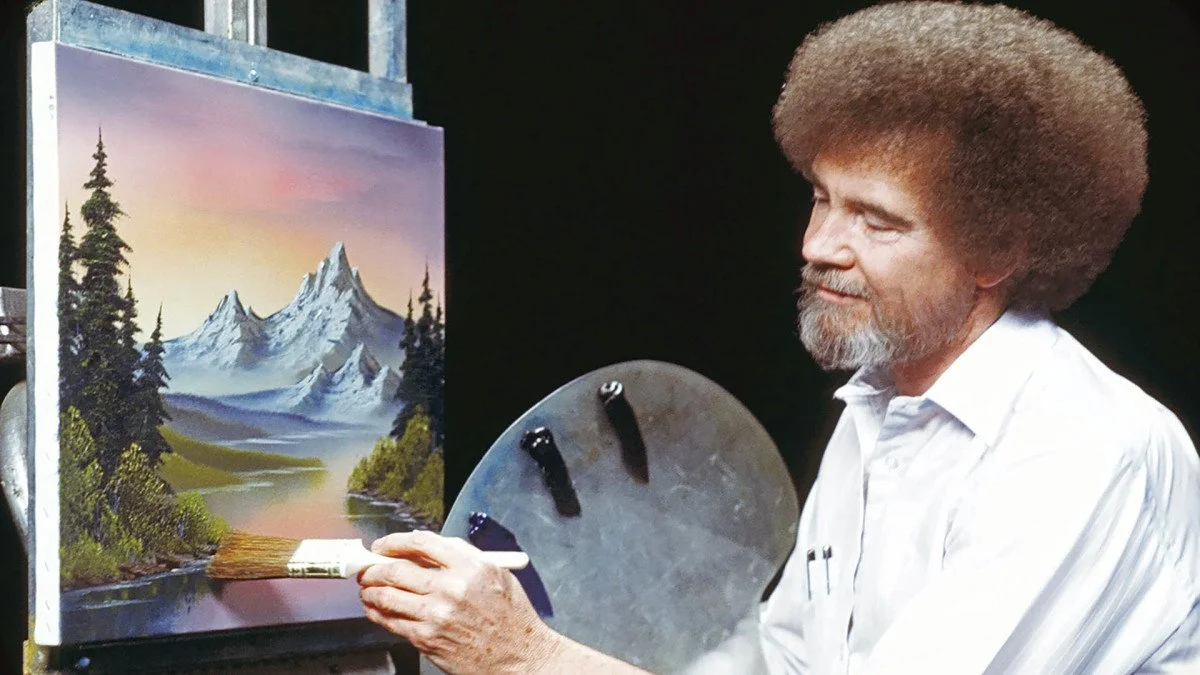Happy Accidents, Essential Funds: Bob Ross's Legacy Supports Public TV Amid Funding Crisis
A collection of 30 original paintings by the late, beloved artist Bob Ross are set to go up for auction, not just as a testament to his "happy little trees" but as a vital lifeline for public television stations struggling under severe federal funding cuts. The auction of the works, many created on air for his iconic show, The Joy of Painting, is a poignant fusion of art, legacy, and public service. Underscoring the indispensable role public broadcasting plays, especially in smaller and rural communities.
Bob Ross - Famed Painter
Who was Bob Ross?
Bob Ross (Robert Norman Ross, 1942–1995) was an iconic American painter and art instructor, best known as the soft-spoken host of the instructional television series The Joy of Painting on PBS from 1983 to 1994. A former Master Sergeant in the U.S. Air Force, Ross captivated millions with his gentle demeanor, distinctive permed hair, and "wet-on-wet" oil painting technique, which enabled him to complete a full landscape painting with happy little trees and happy accidents in under 30 minutes. His mission was to demystify art, making it accessible to everyone, a legacy he perpetuated through his company's art supplies and instructional classes, and through the donations of his on-air paintings to the very public television system he relied on.
The Auction: A "Happy Accident" for Public TV
The decision to auction 30 of his paintings, estimated to be worth between $850,000 to $1.4 million collectively, is a direct response to a fiscal crisis facing public broadcasters nationwide. Congress has eliminated a significant portion of the funding allocated to public broadcasting, forcing approximately 330 PBS and 246 NPR stations to scramble for alternative financial sources. While federal funding may seem small on a national scale, it is a crucial component for local stations, particularly those in rural areas with fewer donors. The cuts have already led to staff layoffs, programming reductions, and an urgent need for emergency funding.
All profits from the Bob Ross paintings auction are pledged to stations that utilize content from distributor American Public Television (APT). The money will specifically help stations cover licensing fees for popular and educational programs, which include:
The Best of The Joy of Painting
America's Test Kitchen
Julia Child's French Chef Classics
This Old House
According to Joan Kowalski, president of Bob Ross Inc., the auction ‘‘ensures his legacy continues to support the very medium that brought his joy and creativity into American homes for decades." It is a continuation of Ross's own generosity, as he often donated his paintings to public television stations for fundraising purposes during his lifetime.
Why Public TV Was Federally Funded
The need for emergency fundraisers like the Bob Ross auction can only be fully understood by looking back at the original purpose of public broadcasting's federal funding. Federal support for public television did not begin as a handout, but as a commitment to an informed, educated, and safe citizenry a public good that commercial media was not designed to provide.
The Public Broadcasting Act of 1967 - This landmark act established the Corporation for Public Broadcasting (CPB), a private, non-profit corporation tasked with insulating public broadcasting from political pressure and serving as the steward of federal investment. The congressional declaration of policy was clear: it was in the public interest to facilitate the development of educational, cultural, and unserved content that was not being provided by commercial broadcasters.
Public television stations are committed to three essential public services:
Providing lifelong learning resources, from early childhood programming (like those featuring Sesame Street) to classroom resources and adult enrichment.
Using their broadcast spectrum for critical, life-saving emergency communications during disasters, often in partnership with first responders.
Offering thorough, thoughtful, and non-commercial historical and public affairs programming to foster a better-informed citizenry and civil discourse.
While local viewer donations and corporate sponsorships are major funding sources, federal funding is considered the "lifeblood" that serves as critical seed money. This federal investment helps local stations, particularly in remote or low-income areas with limited donor bases, maintain the infrastructure required to broadcast and leverage those dollars to secure significantly more funding from non-federal sources.
In essence, federal funding was implemented to guarantee that essential educational and informational services accessible for free and free of commercial interest could reach every American community, regardless of the commercial profitability of the local market.
The auction of Bob Ross's tranquil mountain vistas and "happy accidents" is more than just a novelty sale. It is a tangible, historical effort to bridge a funding gap and protect the very medium that launched his career and carries on the mission he embodied which was bringing high-quality, accessible content to everyone.
Why The Cuts Likely Happened
The controversy surrounding PBS funding largely centers on the show's embrace of LGBTQ+ inclusion. The primary flashpoint occurred when Sesame Street celebrated Pride Month on social media with a message promoting inclusion for all people and families, which drew immediate backlash from conservative politicians and commentators. These critics accused the children's show of promoting a radical agenda and grooming children, which intensified long-standing efforts by some Republican lawmakers to defund them. While Sesame Street itself does not have an explicitly transgender character on the air in the U.S., controversies have also been sparked when actor and singer Billy Porter, known for wearing non-traditional clothing, was announced as a guest star, with critics calling for funding cuts. Also a separate local PBS station project featured a drag queen reading a children's book, which critics linked to the national Sesame Street show to support their argument for defunding the network. The core of the debate is the use of taxpayer dollars for public broadcasting that promotes what some perceive as a liberal social agenda, leading to legislative efforts to eliminate federal funding for PBS and NPR, requiring the auctions of Bob Ross’s famous paintings.

